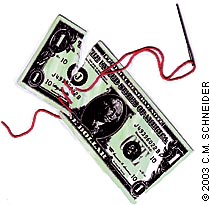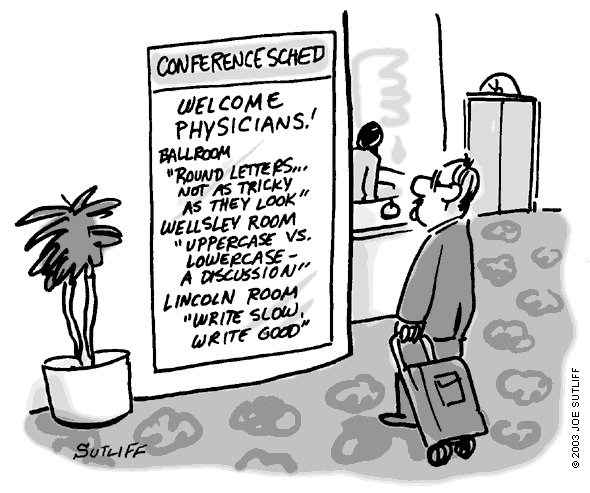
Fam Pract Manag. 2003;10(1):20-26
Patients, physicians underestimate medical errors

Much has been written about medical errors since the Institute of Medicine (IOM) released its 1999 To Err Is Human report. However, until now, little has been known about how physicians and the public view the IOM findings and what they think of the recommended strategies for reducing errors.
A study published in the Dec. 12 New England Journal of Medicine found that while 35 percent of physicians and 42 percent of the public surveyed have experienced medical errors in their own or a family member’s care, neither group considered medical errors to be one of the most serious problems affecting health care today. Physicians ranked the high cost of malpractice insurance, frivolous lawsuits, rising health care costs, and problems with insurance companies and health plans as bigger problems, whereas the public cited rising health care costs and prescription drug costs as their biggest concerns.
The majority of physicians and the public believed the IOM report overstated the number of hospital deaths caused by preventable errors. Instead of the 44,000 to 98,000 preventable deaths cited by the report, they estimated deaths to be 5,000 or fewer and responded that one half or fewer could have been prevented.
Regarding the causes of medical errors, physicians blamed a shortage of nurses (53 percent) and overworked, stressed or fatigued health care professionals (50 percent). The public identified four main causes: not having enough time with physicians (72 percent); overworked, stressed or fatigued health care professionals (70 percent); health care professionals not working together or communicating as a team (67 percent); and a shortage of nurses (65 percent).
While the public thought the majority of 16 proposals presented in the survey would help reduce errors, physicians saw only two of the proposals as being very effective: requiring hospitals to develop systems to avoid medical errors (55 percent) and increasing the number of hospital nurses (51 percent). Physicians and the public also disagreed regarding the effectiveness of error-reduction strategies recommended by experts. For example, the public was much more likely than physicians to believe that the increased use of electronic medical records and computerized systems to order diagnostic tests and drugs would improve patient safety. Robert J. Blendon, a Harvard researcher and lead author of the study called this finding “absolutely staggering,” according to the Dec. 12 Washington Post. Computerized systems have been shown to reduce medication errors in hospitals by more than 80 percent. “It is like giving water to people who are thirsty,” he said. “Everyone agrees it works.”
If organizations hope to succeed in implementing error-reduction strategies, said the study’s authors, they will first need to convince practicing physicians of the efficacy of such strategies.
Medicare payment cuts yet to be corrected

Congress ended its 107th session last year with a number of important health care bills still up in the air, including a bill that would correct the Medicare payment mistake that resulted in a 5.4 percent cut in physician reimbursement in 2002, with an additional 12 percent in cuts still to come by 2005. The House of Representatives passed a bill to correct the mistake last summer, but at press time, the Senate had not yet acted.
In a December letter to members, AAFP president James C. Martin, MD, urged them to write their lawmakers and even to enlist the support of their patients in getting the correction made.
“Senate inaction is unacceptable,” said AMA President Yank D. Coble Jr., MD. “The Senate must pass HR 5063 and fix the mistake that is threatening access to care for Medicare patients. Everyone agrees “this mistake should never have occurred. It should have been corrected many months ago. Any additional delay in addressing these drastic, unintended cuts puts Medicare patients at great risk.”
A recent AMA survey found that 42 percent of physicians say they will not continue to participate in Medicare if there are more payment cuts.
Primary care patient safety research under way

The AAFP Developmental Center for Research and Evaluation in Patient Safety – Primary Care (DCERPS-PC) is launching its first two patient safety research studies. Investigators are currently selecting practice sites and preparing training materials for the two studies: “Physician-, Staff- and Patient-Reported Errors in Primary Care” and “Estimating Rates and Describing Consequences of Testing Process Errors Detected in Family Physician Offices.” Participating physicians, staff and patients will be able to submit anonymous reports on errors to researchers via a secure web site, automated telephone system or mail. For the purposes of the two studies, “errors” are defined as things that happen in the practice “that should not have happened and that you don’t want to happen again.” The errors can be small or large, administrative or clinical. They may even include events or processes that didn’t happen but should have happened. Training of personnel involved in the two studies will begin in February 2003 and data collection in April 2003.
The DCERPS-PC is a project of the AAFP National Network for Family Practice and Primary Care Research. The two studies are partially funded by the Agency for Healthcare Research and Quality.
PRACTICE PEARLS from here and there
Stop searching
Staff members can waste hours of precious time searching for forms in patients’ records or in crammed in-boxes. To make it easier to find what you’re looking for, print forms on color-coded paper. For example, diabetes forms might be printed on green, immunization records on blue, and so on.
– Woodcock E. Find it the first time.
Physicians Practice Pearls. Dec. 12, 2002.
PRACTICE PEARLS from here and there
Learn about your patients
Taking the time to analyze your patient base and understand who they are can help guide your practice’s quality-improvement efforts. Work with your staff to answer questions such as the following:
What is the estimated age distribution of our patients? (e.g., 30 percent of our patients are 65 to 79 years old)
What percentage of our patients are female?
What are the 10 most frequent conditions or diagnoses among our patients?
How many patients do we see in a day?
How many new patients did we see last month?
Do these numbers change by season?
– Clinical Microsystem Action Guide: Improving Healthcare by Improving Your Microsystem. Hanover, NH: Dartmouth Medical School; 2002:18.
Available online at: www.clinicalmicrosystem.org.
255 ways to simplify Medicare
The Department of Health and Human Services (HHS) Advisory Committee on Regulatory Reform, a group of consumers, doctors, nurses and other professionals formed to help streamline the department’s often burdensome regulations, has presented HHS with 255 specific recommendations for improvement, 26 of which have already been implemented. “By restoring common sense to our regulatory system, we are helping health care professionals spend more time caring for patients and less time consumed with paperwork,” Tommy Thompson, HHS secretary, said. The committee’s final report will be available at http://infoassist.panpha.org/docushare/dsweb/Get/Document-5946/pp-2002-HHSregreformfinalreport.pdf.
Could it be true?
Physicians in solo and two-physician practices are significantly more likely to be dissatisfied with their medical career, more likely to report no clinical freedom and more likely to feel income pressure than physicians in other settings, according to a study published in the September–October 2002 Journal of the American Board of Family Practice. Physicians in group practices or staff-model HMOs aren’t completely worry-free, however. According to the study, they are more likely to report feeling time pressure.
Fewer helping hands
The percentage of physicians providing charity care decreased from 76 percent in 1997 to 72 percent in 2001, according to a recent study of 12,000 physicians from the Center for Studying Health System Change. The majority of physicians spent less than 5 percent of their total practice time providing charity services. Mounting financial pressures facing physicians was one reason cited for the decline. The study is available at www.hschange.org/CONTENT/506.
Another 14 percent increase
Employers nationwide expect their health care costs will rise an average of 14 percent in 2003, following a 14.7 percent increase in 2002, according to the National Survey of Employer-Sponsored Health Plans 2002, conducted by Mercer Human Resource Consulting. Growth in hospital charges accounted for most of the increase in 2002. Since 1997, employers’ health care costs have risen 57 percent.

Insurers call for universal coverage
Insurers such as UnitedHealth Group, Blue Shield of California and Blue Cross Blue Shield of Montana are jumping on the universal coverage bandwagon, which they seem to have discovered would not only be good for the uninsured but also good for business. Adding young, healthy members to their pools would spread out the cost of caring for the sick. Insurance companies also are eager to add members whose premiums would be paid with tax money or government subsidies.
Physician owned and operated
With the cost of securing medical malpractice insurance reaching crisis proportions in many states, some physicians are trying to take back control. In New Jersey, for example, a group of physicians formed Conventus Inter-Insurance Exchange and recently received state approval to begin underwriting malpractice insurance. Six out of 10 New Jersey physicians will be forced to find a new medical malpractice insurance company this year as a result of a shrinking market and increases in premiums averaging 40 percent last year.
What’s wrong with this picture?
Chiropractors charge an average fee of $51.94 for the established patient visit code 99213 and get paid an average of $47.97, for a reimbursement rate of 92 percent, reports Chiropractic Economics in its Second Annual Fees and Reimbursement Survey. The report goes on to say that the median fee for all doctors is $52 and the actual payment is $40, yielding a reimbursement rate of 77 percent.
The art of healing
With a little artwork and a few substantial renovations, hospitals are improving overall ambiance and patient care at the same time. One Detroit hospital found that patients treated in its refurbished facility took less pain medication and had lower costs than patients treated before the overhaul, reports the Nov. 27 Wall Street Journal. The Center for Health Design in California recently launched a series of research projects on this topic, which are showing private rooms, natural lighting and even bed curtains with peaceful outdoor scenes may decrease falls, infections and medication expenses.
Evidence on preventive services
You can get easy access to U.S. Preventive Services Task Force recommendations online at www.preventiveservices.ahrq.gov. Recent postings include discussing with patients the use of aspirin to prevent heart disease, which received an A rating, and routine screening for prostate cancer using prostate specific antigen testing or digital rectal examination, which was rated I for insufficient evidence.
So happy together

Not all physicians have been deterred by the criticism of managed care plans over the past few years. According to a survey conducted by the Center for Studying Health System Change (HSC), nine out of 10 physicians still choose to contract with managed care plans. Between 1997 and 2001, the average practice revenue from managed care contracts and the average number of contracts per physician increased. The HSC claims this is the result of physicians and managed care plans seeking a “kinder, gentler approach” to maintaining their relationship.
Paying for quality
Blue Cross Blue Shield of Massachusetts has announced it will begin awarding bonuses to physician groups that provide above-average quality of care or have below-average costs, the Dec. 17 Boston Globe reports. Last fall, several large employers and hospital networks in Massachusetts and six HMOs in California announced similar plans to offer physicians quality-of-care bonuses.
Paying for cultural competency
The health care community’s reaction to cultural competency guidelines issued in December 2000 by the Department of Health and Human Services has been underwhelming, reports the Nov. 25 Chicago Tribune. While many health care professionals believe culturally sensitive care is important, they fear the costs required to comply with new federal mandates. For example, to provide interpretation services to non-English-speaking patients, which is a requirement of the guidelines, a practice in Washington, D.C., could spend $145 per hour, the AMA estimates.